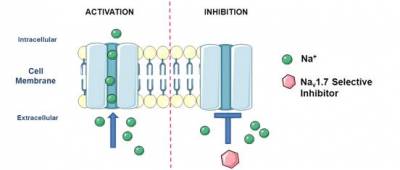Elena Yiannakia, Carlos Perez Medinaa,b, Martin Koltzenburgc, Erik Årstada,b
aUCL Department of Chemistry, Gordon Street, WC1H 0AJ; b Institute of Nuclear Medicine, University College Hospital, 235 Euston Road, London NW1 2BU, UK; c UCL Institute of Neurology, Queen Square. London, WC1N 3BG
Pain affects more than 20% of the population worldwide. Despite many efforts, its efficient treatment remains a great unmet medical challenge. Pain sensations originate in nociceptors. These are peripheral sensory neurons the excitability of which is controlled by voltage gated sodium channels (VGSC, Nav).1 To date, nine different VGSC isoforms have been cloned for the mammalian nervous system. Recent pre-clinical and clinical studies validate Nav1.7 as one of the isoforms with a key role in the pathophysiology of pain.2 Currently marketed VGSC blockers non-selectively inhibit all VGSCs meaning low-systematically tolerable doses and hence limited therapeutic potential.
Our studies focus on developing new Nav1.7
selective inhibitors as the next generation analgesics with improved
efficacy and reduced side effect profile. We have discovered a class of
compounds that appears to selectively block pain signalling whilst
leaving other sensory signalling largely unaffected. Structure-activity
relationships are being elucidated via the design, synthesis and the in
vitro characterisation of multiple structural analogues. Optimised
structures have shown nanomolar activity for Nav1.7 and
exhibit up to 80-fold selectivity amongst other isoforms. Members of the
family have been found to selectively block the nociceptor-containing,
myelinated C-fibres while leaving the smaller unmyelinated A-fibres,
associated with motor control, completely unaffected.

Schematic representation of the sodium channel.
References: 1Theile, J.W. et al., Frontiers in Pharmacology 2011, 2, 54; 2Amir, R. et al., J. Pain 2006, 7, S1.
 Close
Close

